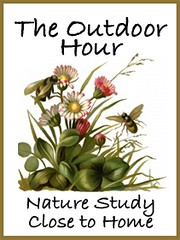Sunday, February 24, 2013
Outdoor Hour - Birds
This month's Outdoor Hour Challenge has been Birds. Most of our focused nature time was spent on owls (which I wrote about here), but we accomplished a few other miscellaneous bird-related activities, as well.
One of the first things we did was identify bird feathers. A great source for identifying bird feathers is the U.S. Fish & Wildlife Service's Feather Atlas. It contains pictures of flight and tail feathers of most common North American birds. The Feather Atlas gives you the ability to identify a feather based upon its pattern and color, or if you think you know the bird that the feather is from, you can search on that bird. I will tell you that there were a couple of feathers that we thought for sure we knew (It's yellow, it must be a goldfinch) and were completely wrong (No, it's a flicker)!
The other source we used for feather identification was the book Bird Feathers. This book was helpful in that it included more than just flight and tail feathers. Using this book, we were able to identify a body-feather of a ring-necked pheasant.
Please note, that it is illegal to possess the feathers, nests, or eggs of over 80% of the birds found in the United States (Birds Protected by the Migratory Bird Treaty Act). If you find a feather, I suggest taking a picture of it for later identification (and also make a note of the date and where you found it - something I neglected to do and would have found helpful). Here is a summary of some of the key provisions of the Act.
We have also been participating in Project FeederWatch. On Mondays and Tuesdays we record the birds that visit our feeders. So far we have seen the following birds:
Dark-eyed Junco - Usually more than one and a sign that other birds are in the area. They are most often under the feeders picking up seeds that the other birds have dropped, but occasionally I'll see them on the feeders, probably knocking food down to their friends. They have a hard time balancing on some of the feeders.
Black-capped Chickadee - a favorite from my childhood.
Tufted Titmouse - they seem to be the least afraid. The only ones that come to our window feeder.
White-breasted Nuthatch - the little acrobats, hanging onto the feeders with their heads below their tails.
Downy Woodpecker - we often see the male and female taking turns.
Red-bellied Woodpecker - the first time I saw this bird, I was just stunned by its red head. I am always excited to see it at the feeder.
American Goldfinch - a little hard to identify in its winter colors
The following have been seen, but not on our FeederWatch days:
Mourning Dove - at first glance these birds seem rather plain, but upon closer inspection they are really quite pretty.
Carolina Wren - saw my first one a year or two ago. We are at the northern end of its range.
Blue Jay - I've always thought of this bird as kind of a pest and it is so numerous here, I take it for granted. It is funny that when we were out west and saw our first Steller's Jay, we thought it was so exotic!
Red-breasted Nuthatch - this is a new one for us. I saw a bird at the feeder that looked like a nuthatch, but something wasn't quite right. It didn't seem big enough. Then I noticed the eyestripe. I took a quick look at the FeederWatch poster that we have hanging on the wall and there it was - Red-breasted Nuthatch. Cool! To be added to my bird life list.
Finally, I came across a book at the library about the Ivory-billed Woodpecker. The book, The Race to Save the Lord God Bird was in the Children's book section, but I found it fascinating. It starts with an account of the early days of ornithology, which seemed to revolve mostly around shooting specimens and then painting pictures of them. Specimens continued to be collected even after it was evident that a species was in decline. The heart of the book was the work done by Cornell and, in particular, Jim Tanner in photographing and recording the Ivory-bill. Because the book was published in 2004, just before the claims of sightings in Arkansas came to light (after not having a documented sighting in the US since 1944), I decided to watch the 2010 video, Ghost Bird. The video shows footage from Arkansas that some say shows an Ivory-billed Woodpecker in flight. However, the video is contested by others, including famed ornithologist David Sibley, who have come to the conclusion that the bird in the video is something else, possible a Pileated Woodpecker.
I really hope that the bird still exists, but given the lack of sightings and the loss of habitat, it seems unlikely. One of the positive aspects of the search for the Ivory-bill has been the preservation of habitat. The drawbacks, which I had really not considered until reading and watching the video, are that millions of dollars are being spent to hopefully bring about the recovery of the species. That means millions of dollars less for other, perhaps more viable, projects. An interesting debate.
Labels:
birds,
Outdoor Hour
Subscribe to:
Post Comments (Atom)



There is always so much to learn when it comes to birds and so many aspects to consider like you bring up with the Ivory Billed Woodpecker.
ReplyDeleteThank you again for sharing your study and resources.
Enjoyed reading this in the HONS Blog Carnival! Thanks for sharing.
ReplyDeleteThanks, Lisa!
DeleteSarah